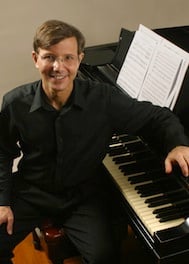Talking to Robert Kapilow is like running to catch a train already disappearing in the distance. He and his ideas are always down the track ahead of you. The other day, I got him on the phone. “I only have a few minutes,” he said. Fifty minutes later, he said he really had to go. He was due at Lincoln Center. But then something else came to mind.
“Originally, I was going to be a conductor of the New York Philharmonic,” he said. “But then as I got closer I found I just could not could bear the lack of connection — and the assumption that this is really just about ‘great music, greatly played.’ So, I made a decision: I will not do this if people don’t get it, if they don’t feel a connection. That’s why I will never do a traditional concert. If it’s not real, I don’t want to do it. Now, I really have to go.”
If it’s not real — what does that mean?
The Real Rob Kapilow

And who is this man, finally? It’s hard to say. Part chess player inside the mechanical Turk; part Illustrated Man; part Lawrence of Musical Arabia. And every bit a pragmatist, as strange as that may sound. Otherwise, a conductor, composer. Yale, Eastman School of Music. He does the NPR program What Makes It Great? It has been said of him that he communicates about music better than anyone in America. His Green Eggs and Ham is becoming the Peter and the Wolf of a new generation.
He’s also the creator of a new form he calls Citypieces. Imagine the New Yorker’s “Talk of the Town” pieces set to music. He’s done five of these things in different cities. Then, a year ago, the Marin Symphony calls with a job offer: They want something to mark the 75th anniversary of the opening of the Golden Gate Bridge.
Of course, he says, and then in the next breath, and over the next few weeks, he confronts once more the problem of doing a project like this — because there’s always the question, “Is the interest here more to describe or to teach?” Or both?
It would be so normal to do either one: to compose a little symphony or else to construct a musical diorama, not unlike what the San Francisco Symphony is doing with its Barbary Coast program — to get up on a podium and give a musical lecture about a 4,200-foot-long wonder of the world. But Kapilow has another idea. And actually his approach may be one ingredient in conserving classical music in America.
This is a man who prefers to approach a thing indirectly. In that sense, the real significance of this project, the newness of it, is the process. Which began simply with meeting people: senior citizens, kids, administrators, toll takers, cops, engineers, filmmakers, historians, Native peoples, and then the relatives of those who have jumped. Indeed, Kapilow spent six hours listening to those particular stories. He got access to notes, letters, remembrances.
One sentence from a jumper’s note stays in his mind, like an earwig: “I think I am broken.”
Meanwhile, as Kapilow went from person to person, from group to group, he began to see something: a 20-minute piece in four movements, with the second movement called “Belief: Suspended.” It would be a blend of music, snippets of voices, natural sounds, artificial sounds, words, chords, and chorus. No video, just sound and music, but woven together so that neither stands apart from the other. From the start, this was a piece that must stand alone, he thought, a kind of parallel structure, an orchestral work that becomes a bridge of its own. And then, after looking into the history of “the Gate” (and the naming of it, in 1846, by an engineer named Fremont, who was reminded of a harbor in Istanbul), Kapilow called his work Chrysopylae (pronounced kris-SOP-i-lee), which means “Golden Gate.”
It has been said of Rob Kapilow that he communicates about music better than anyone in America.
Kapilow says, “The piece is a blend of fiction and nonfiction. But never, in any sense, a documentary. Think of [novelist E. L.] Doctorow. It’s rooted in fact but by no means limited to fact. As opposed to, say, Billy the Kid. What [Aaron] Copland said was, ‘Don’t give me too many facts, because I want to imagine this character myself.’ I would say, in terms of process, we followed opposite paths but to the same end.”
Out of the Mouth of a Sound Effects Genius

Kapilow’s sound advisor on the project was Fred Newman, best known for his vocal sound effects on the long-running radio show A Prairie Home Companion. Their collaboration was essential to a key decision early in the project. The question that naturally arose was when to start the story of this bridge: With its opening on May 27, 1937, and the singing of There’s a Silver Moon on the Golden Gate? Or the time the bridge was conceived — by the true designer, Charles Alton Ellis, not the credited designer, Joseph Strauss? Or when the Miwok and the Ohlone pondered the distance between one shore and another? Or with the Gate at the beginning of time, as it would have appeared to ducks and geese?
Kapilow wanted to avoid direct storytelling. “I don’t want to pin things down, I don’t want to stop the conversation. I want to leave whatever associations there are, open.” So his solution to the problem of “when” was to weave the sound of animals, particularly geese, into an otherworldly buzz created by Newman. The sound comes out of a little contraption made of rubber bands and paper, to which you attach a cord, which you whirl above your head until it makes an oddly primordial sound.
Goal Has Always Been Connection
As April ends, it’s all starting to come together but, as often happens, there isn’t much time to perfect it. The first full rehearsal is April 30. There will be three other rehearsals, then two shows, on May 6 and 8. Kapilow’s piece will be followed by Beethoven’s Ninth Symphony (which had only two full rehearsals before its premiere).
“What I’m saying to people is, ‘You’re in the piece with me.’”
Kapilow would have preferred other company. “‘Only one thing,’ I said. ‘Please don’t put this with Beethoven’s Ninth.’ I was being partly facetious. Of course there are resonances with the Ninth. It’s just difficult being with the greatest piece of music ever written.”
There’s a philosophical aspect to Kapilow’s reluctance to be set alongside Beethoven. Apart from the greatness of his music, Beethoven conjures up the very obstacle that Kapilow pushes against so skillfully: the assumption that classical music is, finally, a passive medium — that you live off the taste of a relative handful of diehards and that’s all there is, that all classical music needs to be is “great music, greatly played.”
“That’s the problem,” Kapilow remarks. “You have to really engage. So many organizations have the best intentions, but relevance remains theoretical. Every conversation I had about the piece is the piece. I don’t consider the performance as more important than that. Whether the workers I met on the bridge, or the families of those who had committed suicide. Or the Indians I spoke with. Or the senior citizens. That’s the piece. And what I’m saying to people is, ‘You’re in the piece with me.’ Otherwise, these connections we’ve been depending on for all these years seem fake. After all, as the saying goes, ‘The only thing less interesting than classical music is new classical music.’”
Kapilow is the first to acknowledge that this engagement, making this connection, is tremendously difficult. It takes money and, most of all, time, and in the beginning the payback may be small. But that’s what he means when he says, “If it’s not real, I won’t do it.”
“I’m in the audience business,” he says. “I’m on the other side of the footlights. I’m part of the shift from ‘me’ to ‘we’ and the conviction that true self-expression happens out there. That the audience is the key. And if it’s not happening out there, then we, as musicians, conductors, and composers, are expressing nothing.
“I really have to go.”
One other thing you should know. If you’re in the audience, you will receive no libretto, no explanations, no translations of Indian words. There is nothing to keep track of. Nothing to learn. Kapilow wants you simply to look up, respond to sound, indulge the prerational, let the mind go, and connect directly.

